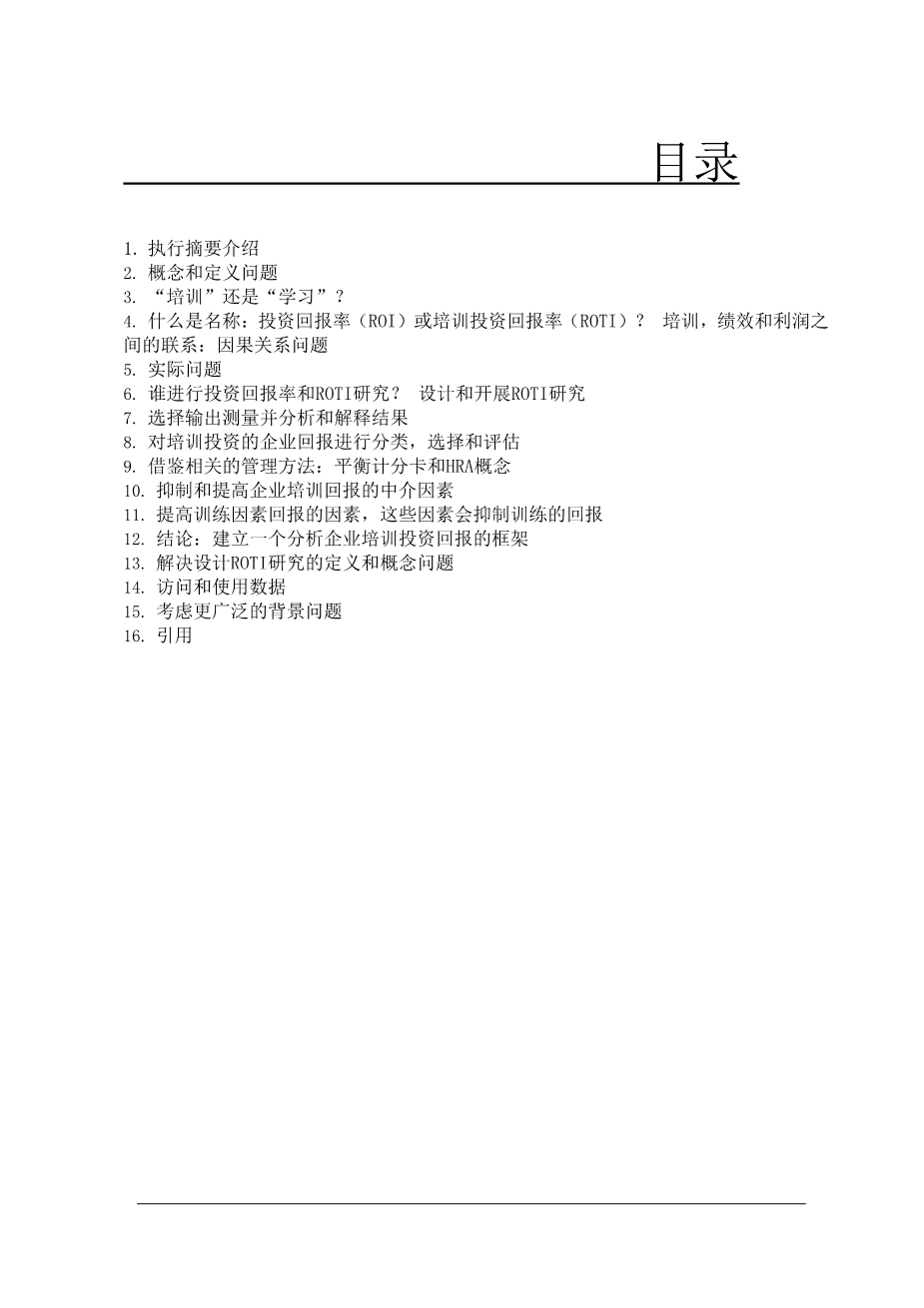企业培训回馈分析外文翻译资料
2023-09-06 11:10:17
➧S
T R A I N I N G
analysing enterprise
returns on training
Janelle Moy Rod McDonald
analysing enterprise
returns on training
Janelle Moy Rod McDonald
Australian National Training Authority, 2000
This work has been produced by the National Centre for Vocational Education Research (NCVER) with the assistance of funding provided by the Australian National Training Authority (ANTA). It is published by NCVER under licence from ANTA. Apart from any use permitted under the Copyright Act 1968, no part of this publication may be reported by any process without the written permission of NCVER Ltd. Requests should be made in writing to NCVER Ltd.
The views and opinions expressed in this document are those of the author / project team and do not necessarily reflect the views of the Australian National Training Authority.
ISBN 0 87397 666 5 print edition
0 87397 667 3 web edition
TD /TNC 64.08
Published by NCVER Ltd
252 Kensington Road, Leabrook SA 5068
PO Box 115, Kensington Park SA 5068, Australia www.ncver.edu.au
Quality Endorsed Company
QualitySystem
ISO 9001
Lic. No. 4331
Standards Australia
contents
executive summary v introduction 1
conceptual and definitional issues 3
lsquo;trainingrsquo; or lsquo;learningrsquo;?
whatrsquo;s in a name: return on investment (ROI) or return on training investment (ROTI)? links between training, performance and profits: the issue of causation
practical issues 6
who undertakes ROI and ROTI research? designing and undertaking ROTI studies
selecting output measures and analysing and interpreting results
classifying, selecting and evaluating enterprise returns on training investment 8
drawing on related management approaches: the balanced scorecard and HRA concepts
mediating factors that inhibit and enhance enterprise returns on training 15
factors that enhance returns on training factors that inhibit returns on training
conclusions: towards a framework for analysing enterprise returns on training investment 17
addressing definitional and conceptual issues designing ROTI studies
accessing and using data
considering broader contextual issues
references 21
executive summary
Recent studies indicate that enterprises receive beneficial returns from their investment in training. Human resource practitioners, employers, governments and researchers also agree that more needs to be done to demonstrate the returns to enterprises from this investment. However, many enterprises appear unwilling or unable to actually evaluate these returns and most reported Australian studies have been completed by researchers, rather than enterprises.
This report provides an extensive review of recent Australian and overseas studies in order to identify
- key issues that need to be addressed to encourage increased evaluation of training benefits by enterprises
- successful approaches that may inform future lsquo;enterprise friendlyrsquo; studies of returns to enterprises from investment in training
As many of the models advocated in the literature appear more suited to large enterprises and specialist human resource researchers, the promotion and use of more practical, creative and cost effective approaches is advocated. The report concludes by identifying principles to inform future return on training approaches so that their use becomes more widespread within Australian enterprises of all sizes. These principles include:
- the need for a broad definition of training which incorporates all forms of learning and skill formation
- the merits of using the term lsquo;return on training investmentrsquo; (ROTI) when evaluating and discussing enterprise returns from training, rather than the narrower, quantitative term, return on investment (ROI)
- the importance of ROTI approaches which provide decision-makers with timely, useful and accessible qualitative and quantitative evidence of the contribution of training to the operational and strategic priorities of the enterprise, rather than always attempting to isolate absolute, quantitative proof of the impact of training on enterprise productivity and profits
- undertaking studies in which a small number of qualitative and quantitative training outcome measures are selected and used, with a focus on the use of existing enterprise data (such as personnel records and safety, quality and sales data), where feasible
- maximising the returns from training by ensuring that training decisions and initiatives complement other human resource policies and practices, together with corporate and operational priorities
Drawing from a large range of Australian and overseas training and management studies, a taxonomy of possible training outcome indicators is provided for use in future ROTI studies. Over 50 possible training outcome indicators are identified using seven headings: productivity and efficiency; sales and profitability; quality of products and services; customer service and satisfaction; occupational health and safety; organisational learning and development; and organisational climate, culture and practices. The taxonomy is designed to provide a range of possible training outcome indicators that may be selected, amended, or rejected, depending on enterprise priorities and resources, including the availability of existing enterprise data.
introduction
An increasing number of publications highlight a need for enterprises, and particularly human resource development (HRD) practitioners, to undertake studies which demonstrate the returns on investment in t
剩余内容已隐藏,支付完成后下载完整资料


英语译文共 23 页,剩余内容已隐藏,支付完成后下载完整资料
资料编号:[608641],资料为PDF文档或Word文档,PDF文档可免费转换为Word




